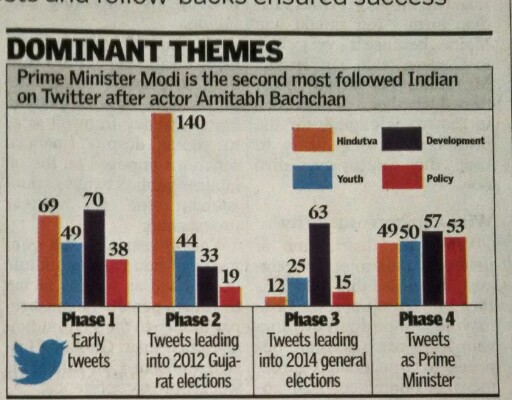The following article was written for MyInd Makers. Reposting it here, for reference.

A news item in The Hindu today needs to be included as a case study in Journalism schools. The topic under which it should be included is this - “What to write if you don’t have enough news for the day?”
The article titled “How Twitter helped created Brand Modi” would be so iconic, if it weren’t so comic! First, let’s take a look at this graph above.
The orange symbolizes “Hindutva”. Typically, newspapers like The Hindu use “Hindutva” as a derogatory term; they use it to symbolize the violent elements of the followers of Hinduism. What does the “research group” define Hindutva as? It defines thus:
“Hinduism theme — referring to “Hindutva” or Hindu greetings, practices, festival and gods — was dominant in the first two phases but drops off significantly leading to 2014 general elections.”
If you are still not able to believe what you just read, feel free to read it again. “Hindu greetings, practices, festival and gods” is now Hindutva. I am at a loss of words to challenge this logic. Quite obviously, India celebrates a lot of lot of Hindu festivals, so tweets wishing Indians on festivals would be quite high! To classify his greetings to fellow citizens on festivals they celebrate under the garb of religion is chicanery at its best.
Not just this, the chart gives the vaguest possible definition of each of the other bars. What does “youth” mean? If Modi wished that the youth of India follow the path of Swami Vivekananda, does it fall under “Hindutva” or does it fall under “youth”? This must rank as one of the worst kind of “research” on a politician’s tweets.
And then 2 full paragraphs are dedicated to tell us how many retweets and favorites happen with Modi’s tweets. I mean – is this what serious researchers actually do? I am sure better research happens in the arts department of JNU!
To me, the most important message from this “research” is this – “It was found that the largest category (of people that Modi follows) belonged to laypersons, which constituted 41 per cent of the accounts. Such a behavior is an exception to the rule…”
It is this “exception to the rule” that makes Modi special. It is indeed remarkable that Modi chose to follow “laypersons” (including this author); and it is because of this “exception to the rule” that the sections of the Lutyens Delhi hates him!

0 comments:
Post a Comment